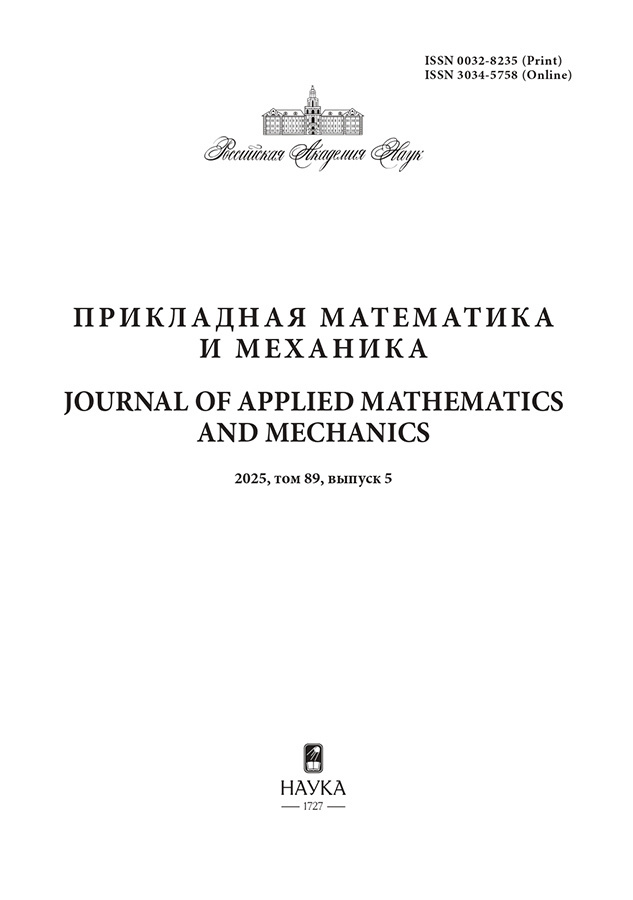Structure of a locally turbulent flow formed when a part of the fluid leaves into the side branch of a circular tube
- Autores: Smirnov E.M.1, Gataulin Y.A.1, Kolesnik E.V.1
-
Afiliações:
- Peter the Great St. Petersburg Polytechnic University
- Edição: Volume 89, Nº 5 (2025)
- Páginas: 703-717
- Seção: Articles
- URL: https://rjsocmed.com/0032-8235/article/view/696409
- DOI: https://doi.org/10.7868/S3034575825050023
- ID: 696409
Citar
Texto integral
Resumo
The results of a numerical study of unsteady viscous fluid flow in the area of the branching of a circular cross-section channel at an angle of 60° are presented for four values of the inlet Re number that are less than or equal to 1475; in the upstream region, the channel flow is assumed to be unperturbed and fully-developed. The main results relate to the case of equality of the flow rates in two branches, with flow separation regions in both branches. It was shown, in particular, that at Re = 750, intense quasi-periodic oscillations develop in the computational domain due to the Kelvin-Helmholtz instability. At Re = 1475, a zone of locally turbulent motion is formed in the flow, the size of which depends on the proportion of the flow going into the side branch. The vortex pattern of the flow and the type of the velocity pulsation spectrum at various points in the region are analyzed.
Sobre autores
E. Smirnov
Peter the Great St. Petersburg Polytechnic University
Email: smirnov_em@spbstu.ru
St. Petersburg, Russia
Ya. Gataulin
Peter the Great St. Petersburg Polytechnic University
Email: gataulin_yaa@spbstu.ru
St. Petersburg, Russia
E. Kolesnik
Peter the Great St. Petersburg Polytechnic University
Email: kolesnik.ev1@spbstu.ru
St. Petersburg, Russia
Bibliografia
- Mallinger F., Drikakis D. Instability in three-dimensional unsteady stenotic flows // Int. J. Heat Fluid Flow. 2002. V. 23. P. 657–663. https://doi.org/10.1016/S0142-727X(02)00161-3
- Sherwin S. J., Blackburn H. M. Three-dimensional instabilities of steady and pulsatile axisymmetric stenotic flows // J. Fluid Mech. 2005. V. 533. P. 297–327. https://doi.org/10.1017/S0022112005004271
- Varghese S.S., Frankel S.H., Fischer P.F. Direct numerical simulation of stenotic flows. Part 1. Steady flow // J. Fluid Mech. 2007. V. 582. P. 253–280 https://doi.org/10.1017/S0022112007005848
- Varghese S.S., Frankel S.H., Fischer P.F. Direct numerical simulation of stenotic flows. Part 2. Pulsatile flow // J. Fluid Mech. 2007. V. 582. P. 281–318. https://doi.org/10.1017/S0022112007005836
- Paul M.C., Molla M.M. Investigation of physiological pulsatile flow in a model arterial stenosis using large-eddy and direct numerical simulations // Appl. Math. Modelling. 2012. V. 36. № 9. P. 4393–4413. https://doi.org/10.1016/j.apm.2011.11.065
- Choi W., Park J.H., Byeon H. et al. Flow characteristics around a deformable stenosis under pulsatile flow condition // Physics of Fluids. 2018. Vol. 30. № 1. P. 1–11. https://doi.org/10.1063/1.5009063
- Freidoonimehr N., Chin R., Zander A. et al. Effect of shape of the stenosis on the hemodynamics of a stenosed coronary artery // Physics of Fluids. 2021. V. 33. № 8. P. 081914. https://doi.org/10.1063/5.0058765
- Гатаулин Я.А., Смирнов Е.М. Численное исследование структуры и локальной турбулизации течения в кровеносном сосуде с односторонним стенозом // Науч.-техн. вед. СПбГПУ. Физ.-мат. науки. 2021. Т. 14. № 1. С. 72–84.
- Mazo A.B., Kalinin E.I., Molochnikov V.M. et al. Simulation of a pulsating flow in a pipe with local constrictions as applied to hemodynamics of blood vessels // Thermophys. Aeromech. 2022. V. 29. P. 249–265. https://doi.org/10.1134/S0869864322020093
- Молочников В.М., Душин Н.С., Пашкова Н.Д. и др. Структура течения и переход к локальной турбулентности за асимметричным сужением, имитирующим стеноз артерии // Изв. РАН. МЖГ. 2023. № 2. С. 72–84.
- Loth F., Fischer P.F., Bassiouny H.S. Blood flow in end-to-side anastomoses // Annu Rev Fluid Mech. 2008. V. 40. P. 367–393. https://doi.org/10.1146/annurev.fluid.40.111406.102119
- Li X., Liu X., Li X. et al. Tortuosity of the superficial femoral artery and its influence on blood flow patterns and risk of atherosclerosis // Biomech Model Mechanobiol. 2019. V. 18. № 2. P. 883–896. https://doi.org/10.1007/s10237-019-01118-4
- Ivanova Y., Yukhnev A., Tikhomolova L. et al. Experience of patient-specific CFD simulation of blood flow in proximal anastomosis for femoral popliteal bypass // Fluids. 2022. V. 7. № 10. P. 314. https://doi.org/10.3390/fluids7100314
- Loth F., Jones S.A., Zarins C.K. et al. Relative Contribution of Wall Shear Stress and Injury in Experimental Intimal Thickening at PTFE End-to-Side Arterial Anastomoses // J. Biomech. Eng. 2002. V. 124. № 1. P. 44–51. https://doi.org/10.1115/1.1428554
- Haruguchi H., Teraoka S.J. Intimal hyperplasia and hemodynamic factors in arterial bypass and arteriovenous grafts: a review // J. Artificial Organs. 2003. V. 6. №. 4. P. 227–235. https://doi.org/10.1007/s10047-003-0232-x
- Jackson M., Wood N.B., Zhao S. et al. Low wall shear stress predicts subsequent development of wall hypertrophy in lower limb bypass grafts // Artery Research. 2009. V. 3. № 1. P. 32–38. https://doi.org/10.1016/j.artres.2009.01.001
- Гатаулин Я.А., Смирнов Е.М., Молочников В.М. и др. Структура трехмерного течения с локальной турбулентностью в области разветвления канала круглого сечения // Научно-технические ведомости СПбГПУ. Физико-математические науки. 2022. Т. 15. № 4. С. 81–94.
- Михеев Н.И., Душин Н.С. Метод измерения динамики векторных полей скорости турбулентного потока по видеосъемке дымовой визуализации // Приборы и техника эксперимента. 2016. № 6. C. 114–122.
- Molochnikov V.M., Mikheev A.N., Mazo A.B. et al. Structure of the proximal anastomosis flow in stationary mode at moderate Reynolds numbers // Thermophys. Aeromech. 2022. V. 29. P. 905–911. https://doi.org/10.1134/S0869864322060105
- Smirnov E.M., Zaitsev D.K., Smirnovsky A.A. et al. Assessment of Several Advanced Numerical Algorithms Implemented in the CFD Code SINF/Flag-S for Supercomputer Simulations // Supercomp. Frontiers&Innovations. 2024. V. 11. № 2. P. 14–31. https://doi.org/10.14529/jsfi240202
- Smirnov E.M., Smirnovsky A.A., Schur N.A. et al. Comparison of RANS and IDDES solutions for turbulent flow and heat transfer past a backward-facing step // Heat and Mass Transfer. 2018. V. 54. №. 8. P. 2231–2241. https://doi.org/10.1007/s00231-017-2207-0
- Смирнов С.И., Смирнов Е.М. Прямое численное моделирование турбулентной конвекции Рэлея — Бенара в слегка наклоненном цилиндрическом контейнере // Науч.-тех. ведомости СПбГПУ. Физ.-мат. науки. 2020. Т. 13. № 1. С. 14–25.
- Колесник Е.В., Смирнов Е.М. Двойственность картины обтекания затупленного ребра сверхзвуковым потоком вязкого газа: влияние малого скоса передней кромки // Изв. РАН. Механика жидкости и газа. 2023. № 1. С. 3–11.
Arquivos suplementares










